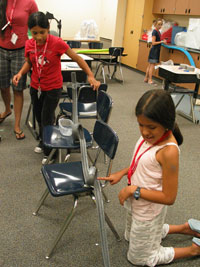 |
Stephanie Andres, left, and Angelica Gutierrez with their ‘ski jump’ after they added the second loop during a science camp hosted by UNMC’s Maurice Godfrey, Ph.D. Both girls are 11 and attend Liberty Elementary School. |
“It’s a blast,” Gutierrez said. “I love science!”
That was music to the ears of Maurice Godfrey, Ph.D., the UNMC associate professor of pediatrics who hosted the four-day July science camp at Liberty Elementary School in Omaha for fifth- and sixth-graders.
“Our summer science camps are designed to show middle school students that science is fun and part of their everyday world, which is one of the many goals of the Science Education Partnership Award (SEPA) grant that funded this,” Dr. Godfrey said.
The science camp was part of a five-year $1.3 million SEPA grant awarded in 2005 from the National Institutes of Health, to strengthen the science curriculum of American Indian youths on reservations in Nebraska and South Dakota.
Two similar camps were held at elementary schools on reservations in South Dakota and northeastern Nebraska.
Liberty Elementary has the highest enrollment of American Indian youth out of all of the Omaha schools.
Dr. Godfrey is the principal investigator of the grant, along with co-investigator Roxanna Jokela, director of the Rural Health Education Network at UNMC.
SEPA grants are designed to improve life science literacy, bring together biomedical and behavioral researchers, educators, community groups and other interested organizations in partnerships to create and disseminate programs that give K-12 students and their teachers a better understanding of life sciences.
Each day of the Omaha science camp focused on a different area, including chemistry, physics, biology and the use of technology in medicine.
On this day, Gutierrez and her partner Stephanie Andres, also 11, were working on a physics project.
The girls made a ski jump with one loop d’ loop out of a grey Styrofoam swim noodle that had been cut in half length-wise.
The goal of the project was to see if they could get glass marbles to glide along the inside groove of the noodle and land in a plastic bowl.
But what they were really doing was learning about gravitational kinetic energy and how height affects velocity.
From the number of glass marbles making it into the plastic bowl at the end of their ski jump, the girls had no trouble figuring out the scientific concepts.
“It works, look it works!” Gutierrez said.
“This is soooo fun,” chimed in Andres.
Successful, the two quickly assembled a new ski jump, this time with two roller coaster style loops.
“We hope that by designing activities using common themes the students’ will better understand the lesson and what they learn this fall in school,” Dr. Godfrey said.